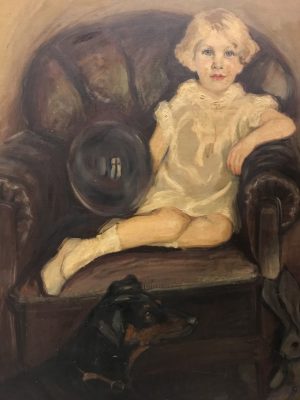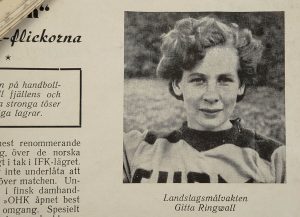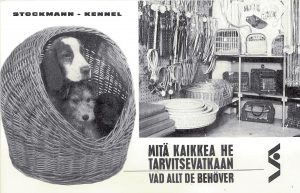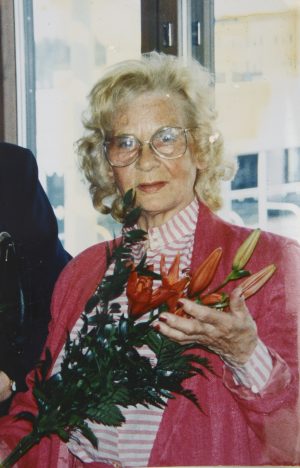Gitta Ringwall’s career included hundreds of litters bred under her renowned kennel Black Spot, a qualification for Ringwall to judge all breeds among the first people in Finland, introducing several breeds to Finland and acting as a founding member of several breed clubs. The Finnish Canine Museum’s exhibition introduces the life and career of the grande dame of the Finnish dog world, Gitta Ringwall.
Unique Gitta Ringwall
Birgit “Gitta” Ringwall (officially Ringvall) was born to a military family on June 8th, 1924. The family – father Erkki Ferdinand, mother Ruth Löfgren and later a younger sister, Margaretha “Metha” – lived by Lake Bodom in Espoo. Even before Gitta was born, the animal loving family had two German shepherds, a Doberman and a smooth fox terrier, so Gitta had experience with dogs from a very early age. In addition to dogs, the family owned cats, cows and hundreds of chickens. These early childhood experiences with animals instilled into Ringwall a lifelong love for dogs and a deep respect for all animals and nature.
At home the family spoke mainly German and Swedish. Gitta learned Finnish at school, and later she learned to speak several other languages, including English, Polish and Czech. She often utilized her diverse knowledge of languages in many different areas of her personal and professional life.

Growing up in the shadow of a war
Due to changed circumstances, Ruth Löfgren moved with her daughters to a smaller house in the beginning of 1930’s. During this time the family dogs had to be rehomed. In 1932 Löfgren bought a new car and got four wire fox terrier puppies and their mother as a part of the car deal. Thus, dogs re-entered the Ringwall household, and this litter was the starting point of the Black Spot kennel, which Gitta initially ran together with her mother.
During the Continuation War in 1943–1944 Gitta worked as a member of Lotta Svärd, in part due to her sufficiency in German. She operated in Emäsalo, Porvoo, where she would send messages with hand signals to a mother ship that was waiting by the coast. She lived in Kauniainen with her sister and mother at this time, near a house where a voluntary fire brigade operated before the war. During the war this house was used as a base for homefront men who would bring the Ringwall family a bucket of leftover food every day to feed to their five dogs. This food was consisted of mainly porridge, meat and vegetables, and Ringwall used this recipe to feed her dogs for as long as her kennel was operational.

Athletic from a young age, Gitta dabbled in many sports, including tennis, baseball and track and field. She played handball on a national level, her team winning indoor championships in 1950, 1952 and 1953. Outdoor championship followed in 1954. Another dear hobby of hers was ballet. Gitta often danced in the Finnish National Opera and Ballet as a part of the ensemble. Eventually her artistic interests began to shift to dog breeding, where she wanted to create something beautiful out of living beings. She was an avid sports fan for the rest of her life, often working as an interpreter for sports events due to her vast knowledge of different languages and different sports.
Passion becomes a career
In the 1950’s, Ringwall began working at Stockmann department store in Helsinki. Her knowledge of German proved once again useful: she was hired as a secretary for the acting store director, Richard Kankkonen, who needed someone sufficient in multiple languages and especially German. After she finished her job as a secretary, Ringwall moved onto become a buyer for the sports and household department.
At the beginning of 1960’s Gitta, who was known at the workplace for her love of dogs, was asked if she would be interested in developing a pet department for the store. The supply of dog products in Finland was rather limited at the time: proper equipment was sold mostly to working dogs, and imported kibbles cost more money to import than they generated. Ringwall agreed, and confidently told the acting director at the time, Holger Kankkonen, that a pet department would be a good investment for the store, and that her connections in the dog world would help the department grow quickly.

Originally the idea was to copy the model for the department from other countries where live puppies were also sold in such departments. Ringwall, however, refused this. She viewed getting a puppy as a great responsibility that could not be sufficiently handled on one run to a store. Instead, customers were welcomed to bring their own dogs to the department when they came to shop there, and Ringwall often had her own dogs with her at work. During the 60’s and 70’s, the pet department grew fast and became a central meeting place for dog enthusiasts. The department became the most well-known and respected place of business for all things canine, and orders were delivered across the country. Ringwall also conducted trimming shows which garnered large crowds of curious spectators, and many who worked at the department have since gone on to become some of the most well-known figures of the Finnish dog scene.
Ringwall managed the pet department at Stockmann for 33 years. Her sister Metha also worked at the department.
A patient mentor and a reliable friend
When speaking to those who knew Gitta Ringwall personally, all describe her with one adjective above all others: kind. They all describe Gitta as always being kind to friends and strangers alike, sometimes even at the cost of her own well-being. She had an amicable personality and was easy to get along with. She was always interested in how her friends and their families were doing and would always bring gifts from her several trips abroad. She would also do charity work, especially on her several trips to Poland:
“In the 1970’s and 80’s I spent every summer in Poland. I drove there with my car full of goods. There were so many poor people. I brought them food and supplies. I still remember the older women saying ‘O Bòge, O Bòge’. That means ‘Oh my God’.” – excerpt from Kaija Unhola’s book: Koiraelämää – Harrastamisen historiaa (2009)

Ringwall was also a teacher and mentor to many breeders at the start of their careers, and many of them bought their first dogs from Ringwall’s kennel or those that she had imported. Many of these beginners have since had successful careers as breeders, judges and handlers. Ringwall would also guide her proteges with trimming and handling different types of dogs.
“We’ve spent many times together, silently contemplating our own things. One New Year’s Eve went by like this in Kari’s (Järvinen) small one room apartment in Kallio, Helsinki. We – Rainer (Vuorinen), Kari and me – will never forget that night. Only with friends can one be silent with ease, with others one might have to.” – excerpt from Pekka Hannula’s book: Kansainvälinen koiratuomari Kari Järvinen (2009)
Last litter under the name Black Spot was born in 2012, and Ringwall cut back on her judging duties even before this. Gitta Ringwall passed away in Espoo on October 4th, 2015, at the age of 91. Black Spot dogs have provided a starting point for many Finnish breeders, but as such the kennel no longer exists.